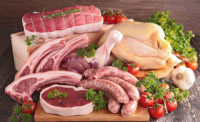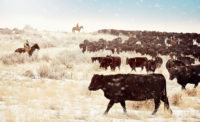After a year of volatility because of avian influenza, smaller cattle herds and weak exports, a quiet rebuilding year is welcome.
This fall, the U.S. Department of Agriculture (USDA) predicted that in 2016, beef production will rise 5.9 percent, pork will be up 0.7 percent, broilers up 2.7 percent and turkey up 7.9 percent.
“In 2016, there is the potential to be a less challenging year with less volatile prices,” says James Robb, director and senior agricultural economist at Livestock Marketing Information Center, in Lakewood, Colo. “We don’t forecast a U.S. recession next year. So barring a return of PEDv [porcine epidemic diarrhea virus] and avian influenza, we could be back to basics: no markets with windfalls — like beef in 2013 and 2014 and pork in 2013 — but also a less dramatic rate of change.”
According to Robb, because beef production is growing in a manageable range, beef prices should start to decrease. Pork and poultry prices are expected to stay relatively the same.
Certainly, the livestock industry and its various segments aren’t a monolithic group, but all were affected by a challenging trade environment.
“Exports were negatively affected by a strong dollar, restricted access to China and Russia and the slowed economy in Asia,” says Kevin Good, senior analyst - fed cattle market specialist and manager of corporate accounts at CattleFax, in Centennial, Colo.
One of the lessons of 2015 is how important trade has become to the meat sector.
“The change in meat per capita consumption was driven by trade and production,” says Jim Mintert, Ph.D., professor in the Department of Agricultural Economics and director of the Center for Commercial Agriculture at Purdue University, in West Lafayette, Ind. “We’ve acclimated to the idea that trade boosts prices. But 2015 is a case in point that soft exports, stronger imports and increased domestic production held down values.”
Making a comeback
Beef has certainly experienced some tough years, with its downsized, smaller herds. In fact, the 2015 harvest was more than 1 million less than 2014, Good says.
However, cattle herds should be up in 2016. The USDA predicts up to 600,000 additional cattle next year, although most analysts think that number is cautious and there will be at least 1 million more, Good says.
“A bigger cattle supply will mean more throughput in packing facilities so that should improve margins,” he adds. “It’s a turning point for the beef industry to have a better chance to make money.”
“Beef retail prices will probably peak in 2015, and we will see some moderation in 2016,” says Derrell Peel, Ph.D., livestock marketing specialist at Oklahoma State University Extension in Stillwater, Okla. “Despite high prices, demand has remained good.”
In addition, beef imports should decrease 9.5 percent and exports could increase 2 percent next year, according to the USDA, which should lead to a tight domestic per capita beef supply and strong prices. How tight? The U.S. domestic beef market will see levels as low as 53.9 pounds of retail weight per capita consumption, for the first time since 1952.
The United States imports significant amounts of beef, usually for processing and ground beef, particularly in 2014 and 2015. “Those imports will start to moderate in 2016,” says Peel, noting our biggest importer, Australia, is in the middle of a drought and will need to rebuild its herds as beef production falls.
Because domestic supply is growing, the decrease in imports shouldn’t greatly affect prices, says Rob Murphy, senior vice president at Informa Economics, in Memphis. Also, relatively low feed costs should stay through 2016.
“They are the root of the supply chain,” Murphy says. “So that should allow producers to raise animals for less, which eventually leads to more product available at lower prices.”
Weathering export bans
This year has shaped up as another profitable year for the broiler industry, albeit a bit subdued from 2014. That’s in large part due to export losses experienced by the industry because of foreign bans over avian influenza (AI) concerns, says Tom Super, vice president of communications at the National Chicken Council, in Washington, D.C.
“The good news is there has not been a positive detection of highly pathogenic avian influenza in the U.S. since mid-June 2015,” Super says. “The bad news is that about 18 countries have banned all poultry imports from the entire U.S. and 43 countries have banned at a regional level.”
The USDA predicts there will be up to 500 new cases of AI this winter, which some claim may be too high a prediction, given the fact that less than 250 cases were reported in the first half of 2015.
Even though the commercial broiler industry was unaffected by the virus this year, chicken exports are included in these bans. Russia, for example, has banned U.S. poultry meat until February 2016.
“From January to August 2015, we’ve had $652 million in export losses,” says Super.
Most of these exports are dark meat/chicken leg quarters, which took a toll on the domestic market as the industry saw an additional $1.3-billion drop in U.S. domestic value, he says.
“Monthly chicken leg quarter prices in Southern states has dropped from about $0.38/lb. (bulk) in January 2015 to $0.15 in October in 2015,” Super says.
Retail and wholesale prices struggled this year, and poultry did not benefit from higher beef prices as much as expected, according to Peel.
“More poultry had to be consumed domestically, so prices decreased, which caused problems for pork and beef, as well,” Murphy says.
The USDA estimates broiler production will be up more than 4 percent in 2015 and another 3 percent in 2016, although some analysts are saying these estimates are bit high for both years. In 2016, the broiler sector also will see some new capacity coming online, as plants are either expanding or being built in Arkansas, North Carolina and Texas.
“The very positive news is that feed costs should remain manageable. Other costs, especially energy, are forecast to be lower, consumer demand for chicken is on track to stay strong and exports will hopefully rebound from the decreased levels experienced this year,” he says. “2016 should be another profitable year for chicken producers.”
AI aftermath
The AI outbreak that hit the northern Midwest — Minnesota, North and South Dakota and Wisconsin — this winter and spring took with it nearly 8 million turkeys. When one factors in extra down time and breeding reductions, the impact could be as high as 20 million birds.
“The overall impact on the turkey supply was 3 percent, but the total poundage may have been higher; it’s just too early to tell,” says Joel Brandenberger, president of the National Turkey Federation, in Washington, D.C. “So nationally the outbreak was managed quite well. But if you were one of the companies affected, it was devastating.”
This epidemic was the largest animal disease outbreak of our time. “I give a lot of credit to the federal government for doing a nice job of ensuring swift identification of product losses,” Brandenberger says.
Turkey processors not hit by AI had a pretty good year because of the higher prices and product shortages.
How quickly turkey exports will recover is up to debate, as international customers restricted trade. In fact, year-to-date shipments were down 21 percent from 2014. Yet in 2016, most trade customers should be lifting restrictions against U.S. companies, so trade should improve, Brandenberger says.
“Turkey needs to rebound from AI, because it hasn’t completely recovered,” says Murphy, noting some producers are still cleaning up from the virus. “In the second half of 2016, production should be up so that will give some relief.”
Recovering from PEDv
Pork is no stranger to disease outbreaks, as it battled PEDv in 2014; however, the industry worked hard this year to continue mitigating the PEDv situation.
“Producers have also increased their herd size, and we are currently on track to have one of the highest pork production years in history,” says Patrick Fleming, director of market intelligence and innovation at the National Pork Board, in Des Moines, Iowa.
Pork sales have performed positively at retail so far this year. According to FreshLook Marketing, for the 52 weeks ending Aug. 23, 2015, fresh pork sales increased 5.6 percent in dollar sales and 2.4 percent in volume sales compared with the same period year ago, as prices fell with increased supplies.
“The pork category has been a great value this year, especially amidst increasing prices of competing proteins,” Fleming says. “While the average retail prices of the total meat category were up 7.3 percent compared to year ago, retail pork prices were up only 3.1 percent.”
In early 2015, the pork industry struggled with poor exports, but is recovering, says Peel: “Exports are important because they represent a significant percentage of pork sales.”
For the livestock industry, uncertainty is normal. Any factor could jump out as a problem at any time, such as a return of AI, PEDv, bad weather, regulatory issues or international turmoil.
Country-of-origin labeling also could have an impact next year if it is rolled back or abandoned by Congress, which should lead to more imports from Mexico and Canada and decreased costs in the supply chain resulting from tracking product.
“There is more influence from private equity capital in markets, too,” says Murphy. “Private equity investors come in, and this leads to a fresh round of cost-cutting as they seek to squeeze every bit of excess cost out. This has been actively taking place the last 18 months across all segments of food.”
All that said, so far, “2016 is shaping up pretty well for processors,” Murphy says. NP
Beef by the numbers
- 2016 retail beef prices will fall as larger beef supplies average near $5.95/lb.
- Feeder cattle supplies will remain tighter than last year throughout second half 2015, supporting a yearly average price near the $157/cwt. As fed cattle supplies increase in 2016, leverage will shift to the packer and pressure fed cattle prices to around $146/cwt.
- Calf prices will average $267 for 2015 and $237/cwt for 2016.
- The 2015 average utility-grade cow prices is $109/cwt. Values will narrow around $10/cwt next year as non-fed beef production increases and U.S. beef imports pull back slightly.
Source: CattleFax








Report Abusive Comment